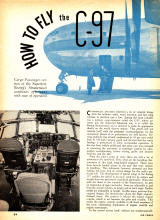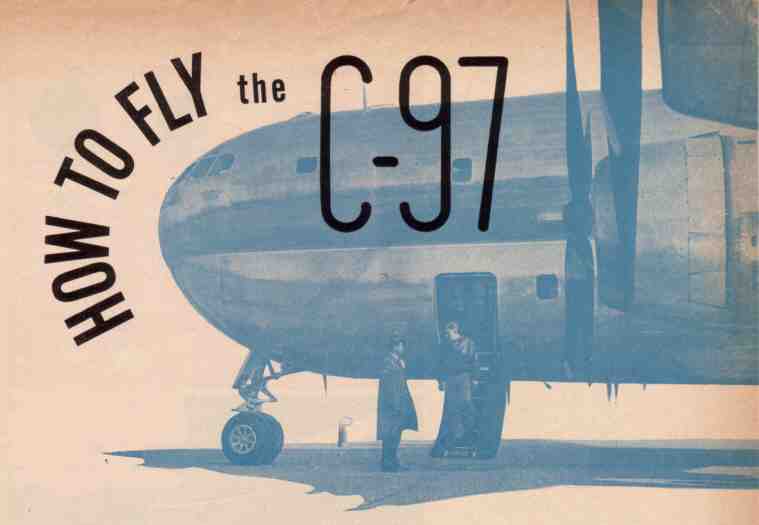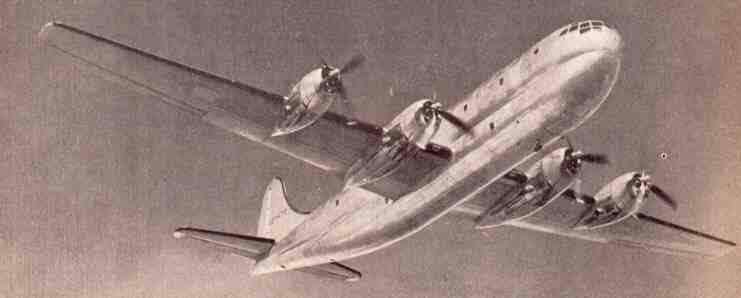

From «Air Force», December 1946


 |
| Cargo-Passenger version o f the Superfort, Boeing's Stratocruiser combines efficiency with ease of operation |
 COMMERCIAL AVIATION inherited a lot of valuable things from the military-radar, water injection, and fast wing sections, to mention just a few. Among the most valuable was a military cargo-transport called the C-97, whose ancestor was the Superfort. Mustered out, it is called the Boeing Stratocruiser, and is destined to make its appearance shortly on the world skyway system. This article will not concern itself with the passenger accommodations, for the commercial phases of its performance are well known. Previous publicity has already emphasized its 43 per cent useful load, its 340-mph cruising speed, and the fact that the entire fuselage is pressurized to allow overweather operation. It has also been widely publicized that great care was exercised in extracting the maximum in passenger comfort by ultramodern soundproofing, luxury seating, galley and lavatory facilities, and the like.
COMMERCIAL AVIATION inherited a lot of valuable things from the military-radar, water injection, and fast wing sections, to mention just a few. Among the most valuable was a military cargo-transport called the C-97, whose ancestor was the Superfort. Mustered out, it is called the Boeing Stratocruiser, and is destined to make its appearance shortly on the world skyway system. This article will not concern itself with the passenger accommodations, for the commercial phases of its performance are well known. Previous publicity has already emphasized its 43 per cent useful load, its 340-mph cruising speed, and the fact that the entire fuselage is pressurized to allow overweather operation. It has also been widely publicized that great care was exercised in extracting the maximum in passenger comfort by ultramodern soundproofing, luxury seating, galley and lavatory facilities, and the like.
From the pilot's point of view, there are still a lot of questions to be answered. First, what are the handling characteristics of this high wing-loaded airplane? There have been heavily loaded planes in the past that were inferior in handling. This inferiority, however, stemmed not from loading but from lack of correct design for the craft's particular job. The development of special wings in the Boeing 117 enables the airfoil to do more work for its surface and weight than was previously considered practicable. When the pilot sits down at the controls of the Stratocruiser, he gets an impression of space and order. Seats are adjustable to and from the control column, in height and in back angle. Rudder pedals are adjustable in height. Unlike many previous fourengined designs, the Stratocruiser allows the flight engineer forward vision. His position is behind the engine control console, which is set between the pilot and co-pilot. This makes the engine controls available to all three members of the crew, eliminating duplication of engine controls and engine instruments.
In the control system itself, surfaces are aerodynamically balanced so that, by the application of properly placed friction reduction, power-boosted controls are made unnecessary. This means that the pilot can still "feel" the airplane. The overhead switch panel marshals all secondary functions such as auxiliary power, hydraulic pressure, and starting configurations. Among the navigational instruments utilized are the drift-sight and ground-speed indicator, Pioneer fluxgate compass, Gyrosyn compass, radio compass, and autopilot.
The cockpit arrangement for the C-97 offers great latitude in operational responsibility. Ordinarily, the pilot starts all four engines, with either the co-pilot or the engineer assisting on mixture and throttles. After starting, engines are run at 1,000 to 1,100 rpm until oil temperature reaches 40°C. Then it is raised to 1600 revs, where prop governors and feathering switch checks are made. Then the warm-up speed goes to 2100 for magneto checks. From here the run is made up to take-off power and turbos are set. All pilots go over the printed check list before taking off.
After getting tower clearance and taxiing to the runway, the flight engineer sets the cowl flaps, and the co-pilot depresses the flap to 25° for take-off. The nose wheel, on a vertical pivot, centers automatically. Two methods for takeoff are possible. On a long runway, power is applied gradually, with differential throttles used to maintain course in the early stages. For short fields, brakes are applied and throttles are opened, then brakes are released gradually. A straight course is maintained by using both brakes and rudder. The control wheel is eased back at 90 mph to clear the nose wheel from the runway. The airplane will fly itself off at 100 to 120 mph depending on the load.
Once the ship clears the ground, brakes are applied to stop the rotation of the wheels and the landing gear is retracted. At 140 to 160 mph indicated, the flap is pulled up, and power is reduced from a manifold pressure of 49 inches of mercury to 43.5 inches in the first stage. At about 1,000 feet, cruising climb power reduction is made, cutting to 39 inches. The flight engineer sets the cowl flaps to "cool" after the first power reduction.
The C-97, like every other airplane whose design was influenced by the late Edmund T. Allen, is easy to control. One hand on the wheel is enough for any maneuver. There is a minimum unbalance when the gear is down or the flaps are extended, and no trim set change is required.
In flight the engineer, who handles the fuel system, shuts off fuel boost pumps one at a time, checking the fuel pressures carefully as the change is made to engine-driven pumps. Intercoolers are adjusted to about half open, to give proper carburetor air temperature. Since the aircraft is so large, the flight engineer can simply go downstairs and check landing gear and flap position from a window in the lower deck. At 10,000 feet, the C-97 will indicate 200 mph at 60 per cent of power, 1,200 hp per engine. After leveling off, the flight engineer cuts back to auto-lean for the remainder of the trip. At cruising altitude, the plane is turned over to the automatic pilot, and the navigator becomes the hardest working member of the crew.
During descent it is good practice to build up a little speed to make up for time lost in climb to altitude. In going up or coming down, the flight engineer handles cabin pressure controls. While the actual pressurization is automatic, his job is to check its operation and make sure that doors and hatches are closed. He also checks temperatures for passenger comfort, operating the regulator on the co-pilot's panel.
In actually coming in the co-pilot lowers the landing gear at 190 mph indicated, on the downwind leg of the approach. On the base leg, flaps are lowered to 25°. The approach is made at 150 mph, and full flap is lowered two or three miles away from the field. Because of the connected trim tab system, no manual adjustment is required in lowering flaps.
While the pilot is making power adjustment, the co-pilot gets tower landing instructions. Final approach is made at 125-130 mph. Props are set at 2400 rpm, and manifold is set for full take-off horsepower, just in case. The Stratocruiser lands at 100 mph, and can be flown in or flared out before it touches down.
Normally the nose wheel is kept off the ground for the first thousand feet, but it can be dropped immediately for cross-wind landings. Full brakes can be applied for short stops, and on both the late series C-97 and the commercial Stratocruiser reversible pitch propellers are available to cut the run even further.
Once on the ground, the flaps are pulled up by the co-pilot. Except on abnormally hot days, the cowl flaps are kept closed during approaches.
| C-97, with highest wing loading of any plane in operation, has easy control. |
 |